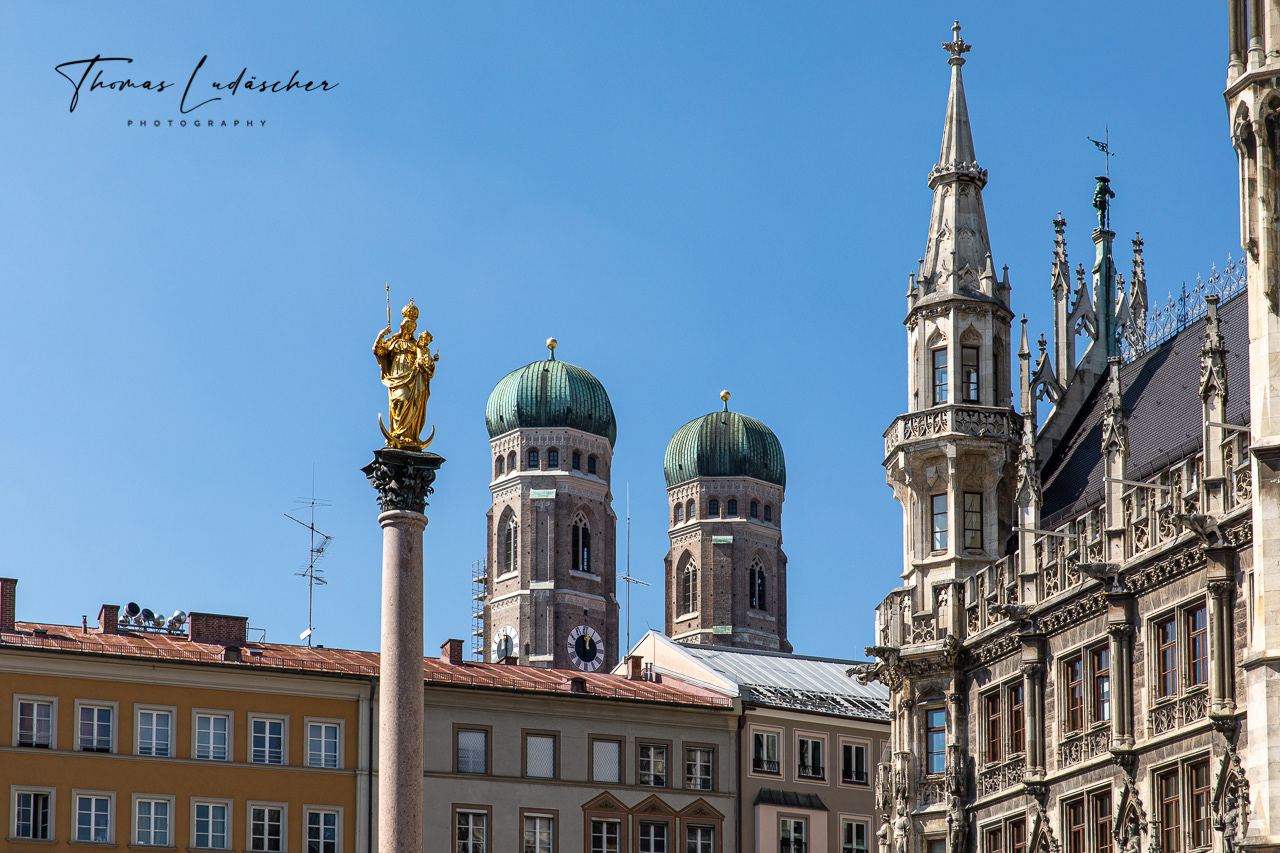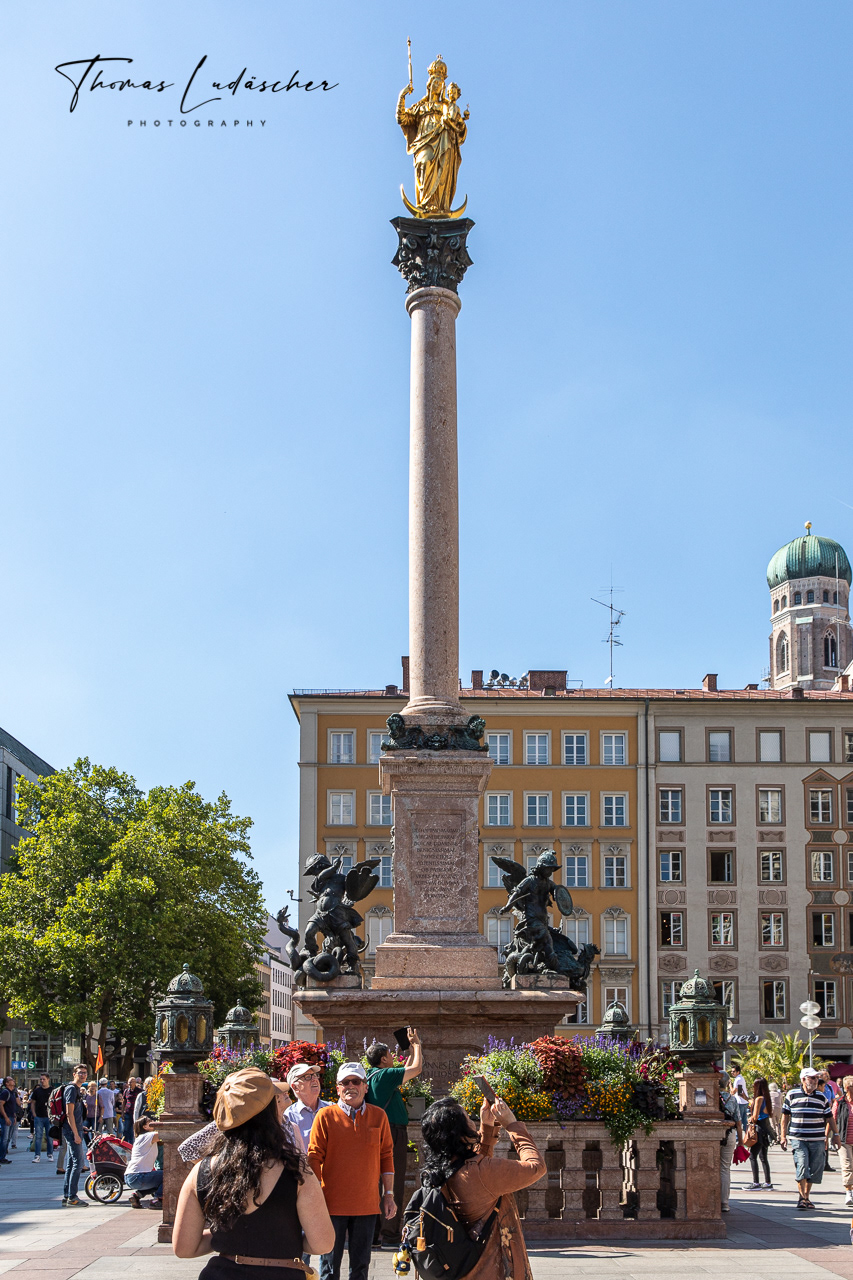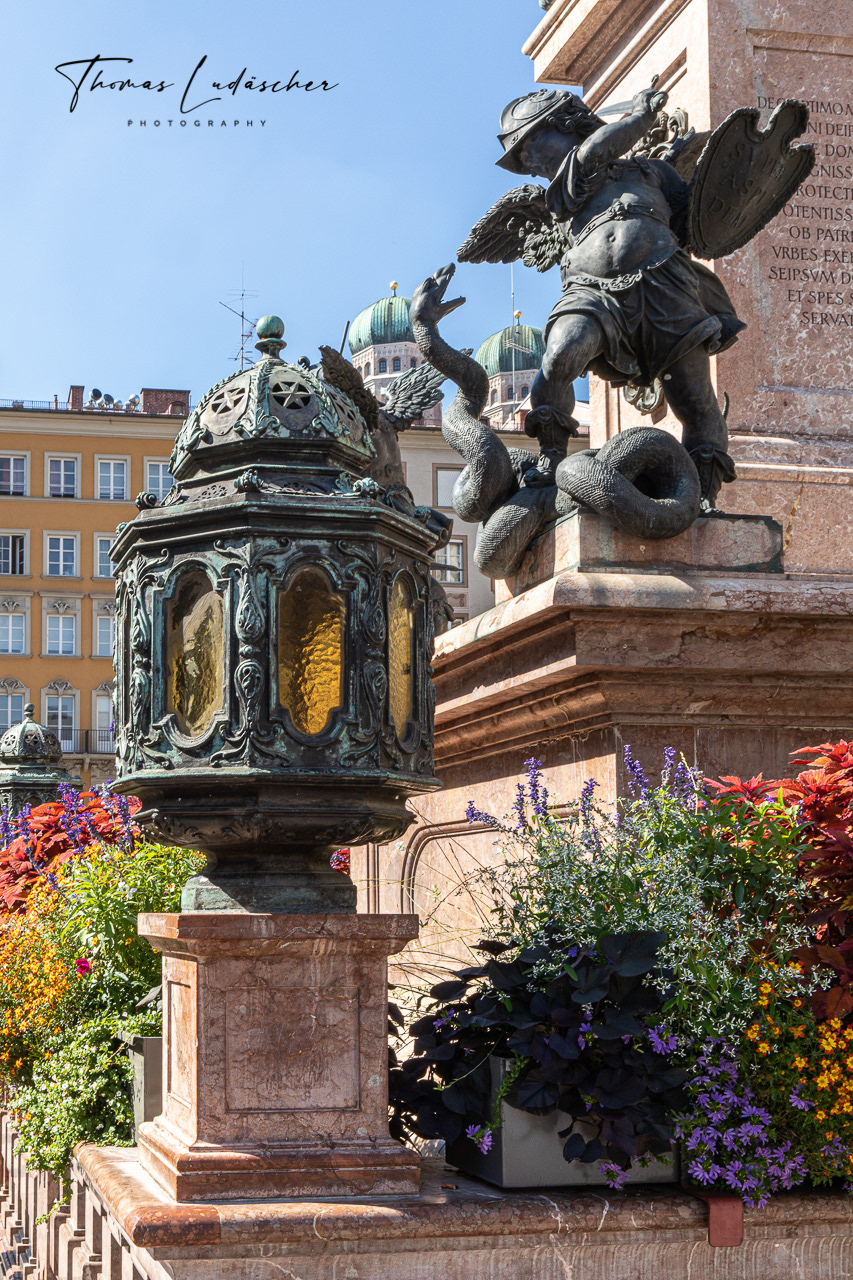Viktualienmarkt
Der Viktualienmarkt (Aussprache: Fiktualienmarkt) ist ein ständiger Markt für Lebensmittel (veraltet auch Viktualien) in der Altstadt von München. Er findet seit 1807 täglich, außer an Sonn- und Feiertagen, statt.
Das Erscheinungsbild des über zwei Hektar großen Geländes wird durch fest errichtete Buden mit zum Teil großen Auslagen geprägt. Dazu kommen einige saisonal unterschiedliche fliegende Stände. Die Marktstände sind in mehreren Abteilungen um einen Biergarten angeordnet. Das Gelände wird außerdem durch Münchens zentralen Maibaum und mehrere Brunnen geprägt.
Der Viktualienmarkt am heutigen Ort entstand aus der Verlegung des alten Münchner Stadtmarktes am Schrannenplatz, dem heutigen Marienplatz.
The Viktualienmarkt (pronunciation: Fiktualienmarkt) is a permanent market for food (also known as Viktualien) in the old town of Munich. It has taken place every day since 1807, except Sundays and public holidays.
The appearance of the site, which is over two hectares in size, is characterized by permanently erected stalls, some of which have large displays. There are also some seasonally different temporary stands. The market stalls are arranged in several sections around a beer garden. The area is also characterized by Munich's central maypole and several fountains.
The Viktualienmarkt at its current location was created when the old Munich city market was relocated to Schrannenplatz, today's Marienplatz.
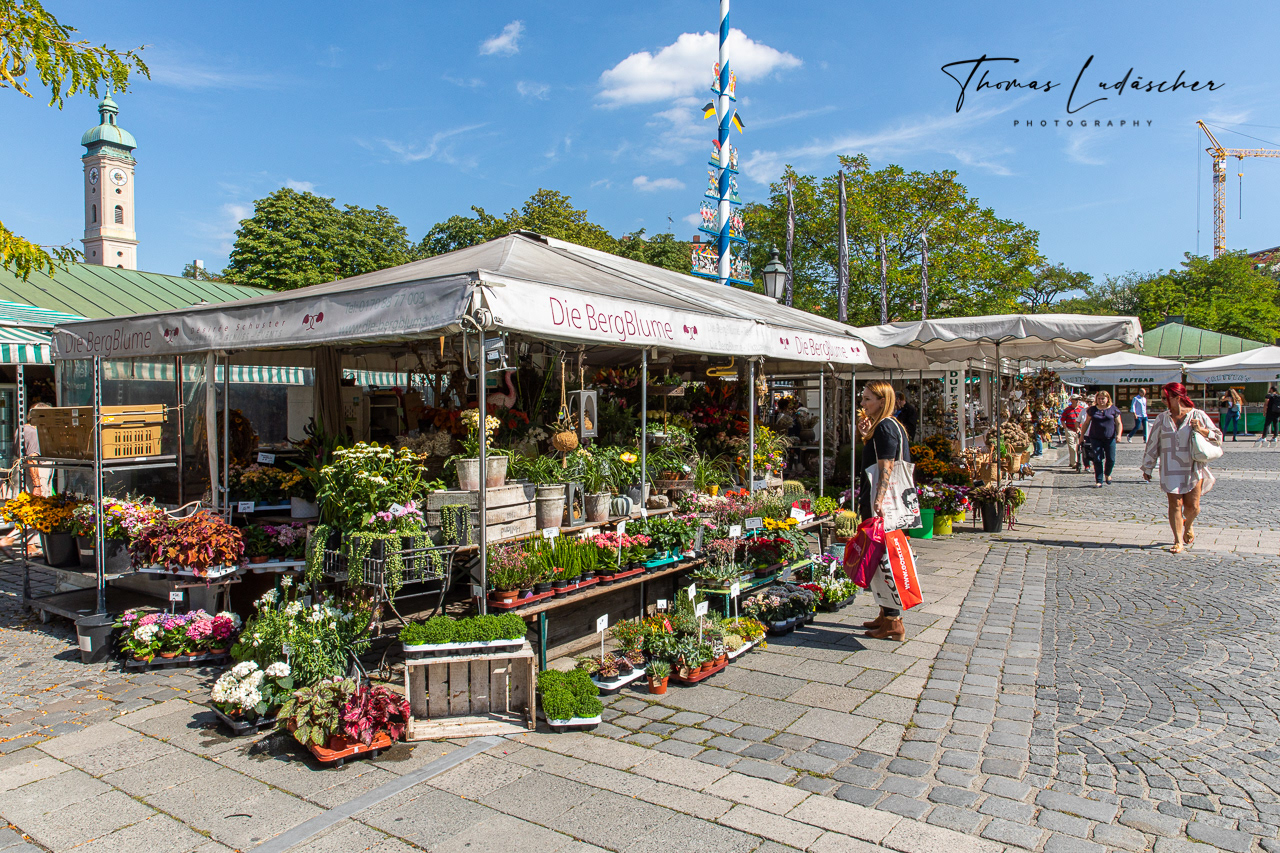

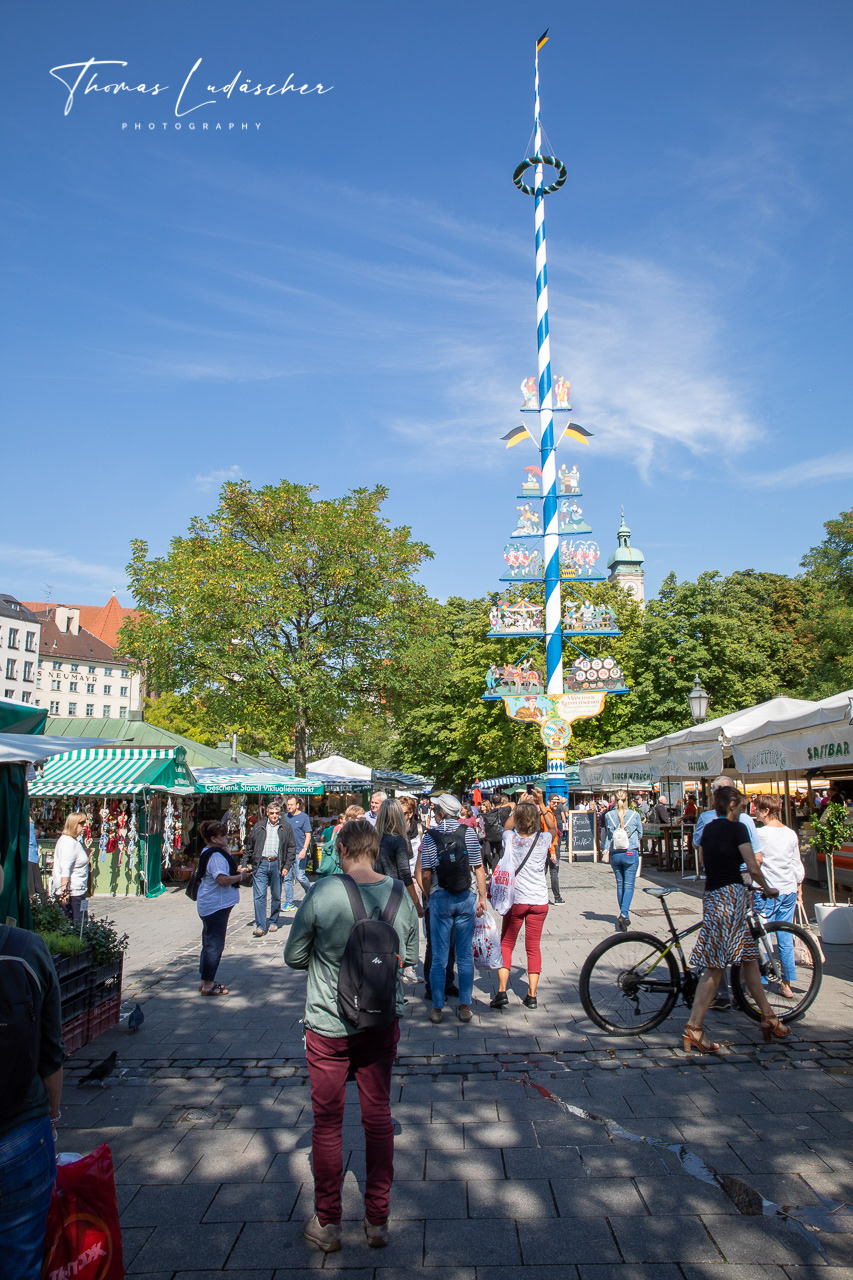
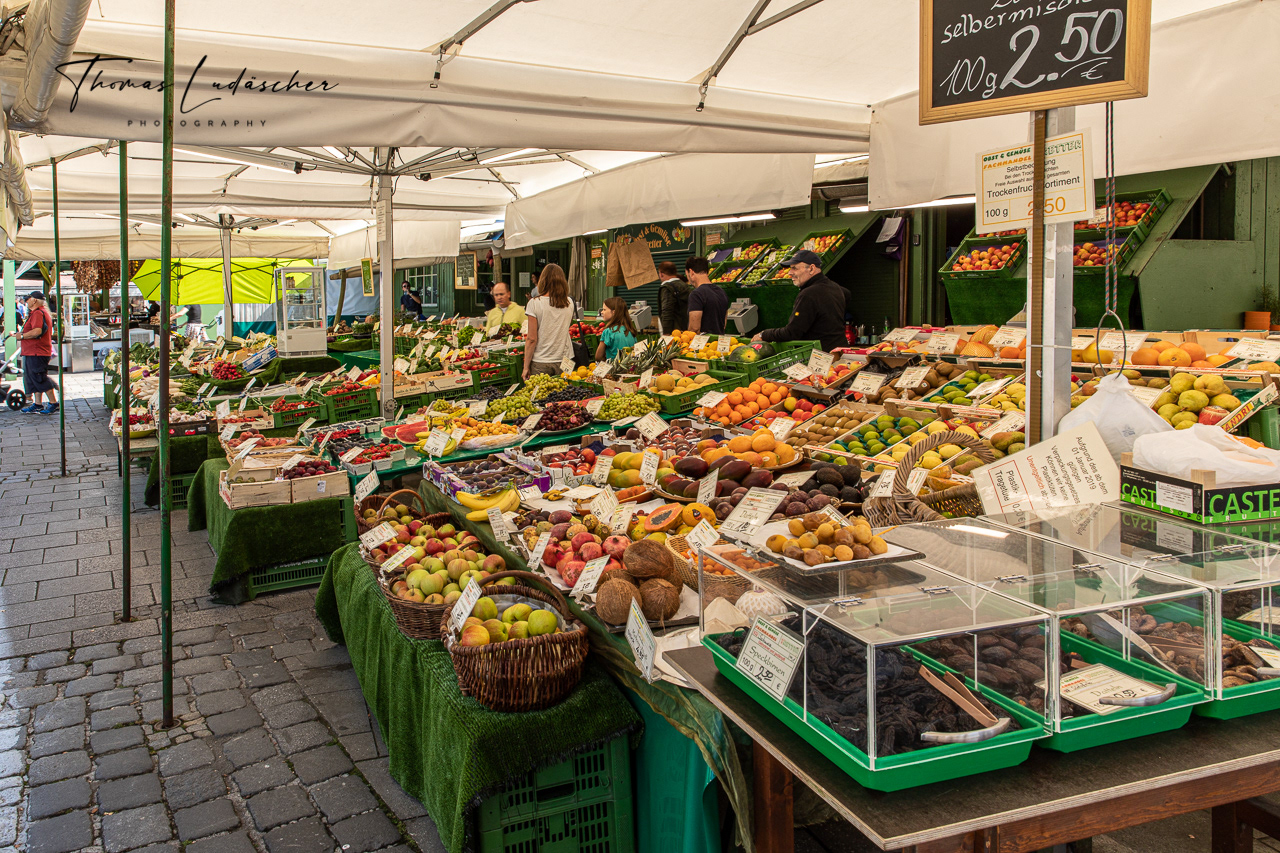
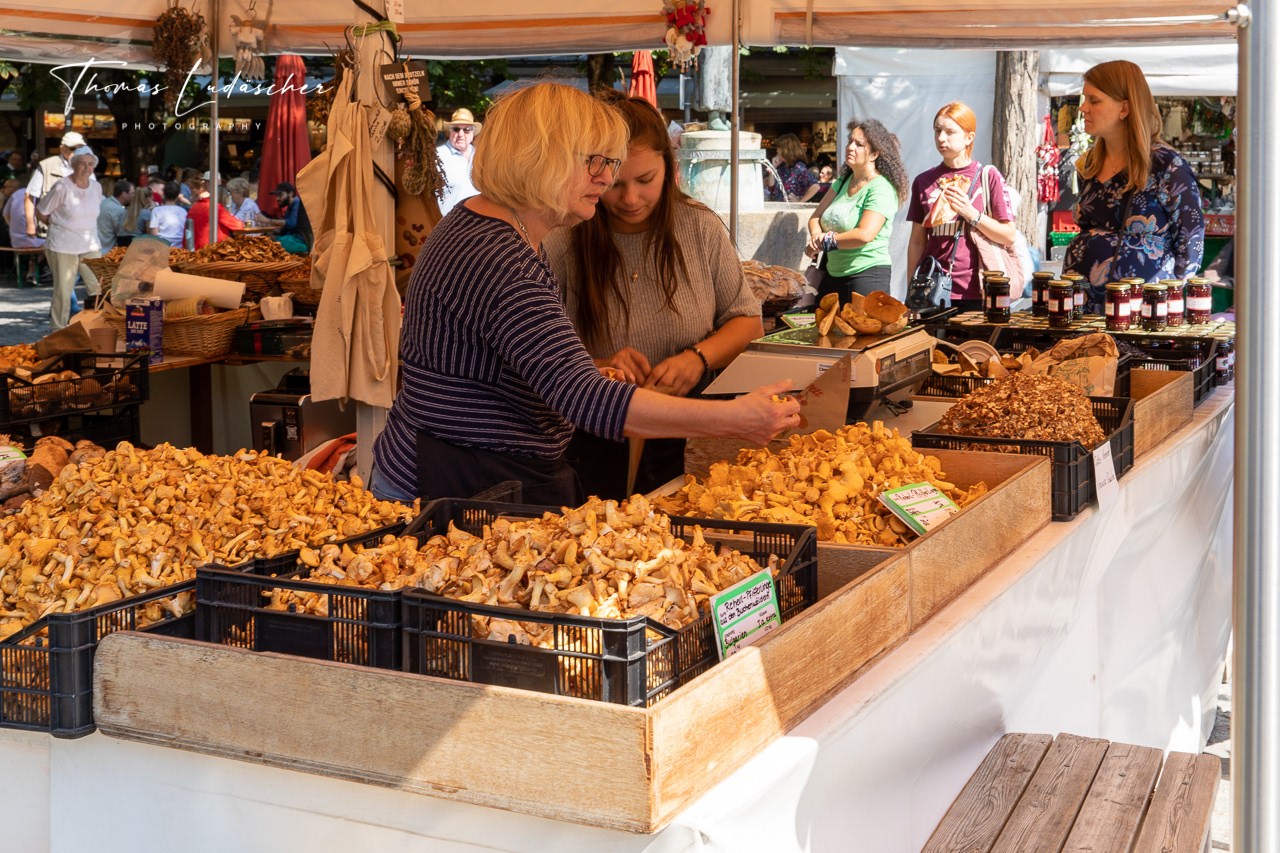



Im Tal
Altes Rathaus (Bild links und Mitte)
Das Alte Rathaus am Marienplatz ist ein Repräsentationsgebäude der Stadtverwaltung in der Münchner Altstadt. Es wurde von 1470 bis 1475 durch Jörg von Halsbach im spätgotischen Stil erbaut und war bis 1874 Sitz des Münchner Magistrats. Über eine Brücke wird das alte Rathaus mit dem Gebäude der Stadtsparkasse verbunden.
Heilig-Geist-Kirche (Bild rechts)
Wahrscheinlich 1208 gründete Herzog Ludwig I. der Kelheimer ein Spital, das direkt außerhalb der alten Stadtmauer vor dem Talburgtor lag. Zu diesem Spital gehörte eine romanische Kapelle, die der heiligen Katharina von Alexandrien geweiht war. Diese Kapelle entstand wohl bereits bei der Gründung des Spitals. Erstmals erwähnt wird sie in dem Schutzbrief des Papstes Innozenz IV. von 1250 für das Spital als „ecclesia sancti spiritus de Monacho“, also Heilig-Geist-Kirche von München, wohl in Anlehnung an den Namen des Spitals. Ansonsten wird sie bis ins 14. Jahrhundert als Katharinenkapelle bezeichnet.
Old Town Hall (picture left and middle)
The Old Town Hall at Marienplatz is a representative building of the city administration in Munich's Old Town. It was built from 1470 to 1475 by Jörg von Halsbach in the late Gothic style and was the seat of the Munich magistrate until 1874. The old town hall is connected to the city savings bank building via a bridge.
Holy Spirit Church (picture on the right)
Probably in 1208, Duke Ludwig I of Kelheim founded a hospital that was located just outside the old city wall in front of the Talburg Gate. This hospital included a Romanesque chapel dedicated to Saint Catherine of Alexandria. This chapel was probably built when the hospital was founded. It is mentioned for the first time in Pope Innocent IV's letter of protection for the hospital from 1250 as "ecclesia sancti spiritus de Monacho", i.e. Holy Spirit Church of Munich, probably based on the name of the hospital. Otherwise it was referred to as St. Catherine's Chapel until the 14th century.



Platzl
Der altmünchner Straßenname Platzl besteht an dieser Stelle seit mindestens 1780. Er bezeichnet die platzartige Erweiterung der dort endenden nördlichen Orlandostraße. Das berühmteste Gebäude am Platzl ist das Hofbräuhaus (rechtes Bild). In unmittelbarer Nähe davon gruppieren sich weitere Lokalitäten wie Alfons Schuhbecks Südtiroler Stuben, das Orlando Haus (Lines Bild), das Platzl Hotel und ein Hard Rock Cafe.
The old Munich street name Platzl has existed at this point since at least 1780. It refers to the square-like extension of the northern Orlandostrasse that ends there. The most famous building on the Platzl is the Hofbräuhaus (right picture). In the immediate vicinity there are other locations such as Alfons Schuhbeck's Südtiroler Stuben, the Orlando Haus (left picture), the Platzl Hotel and a Hard Rock Cafe.
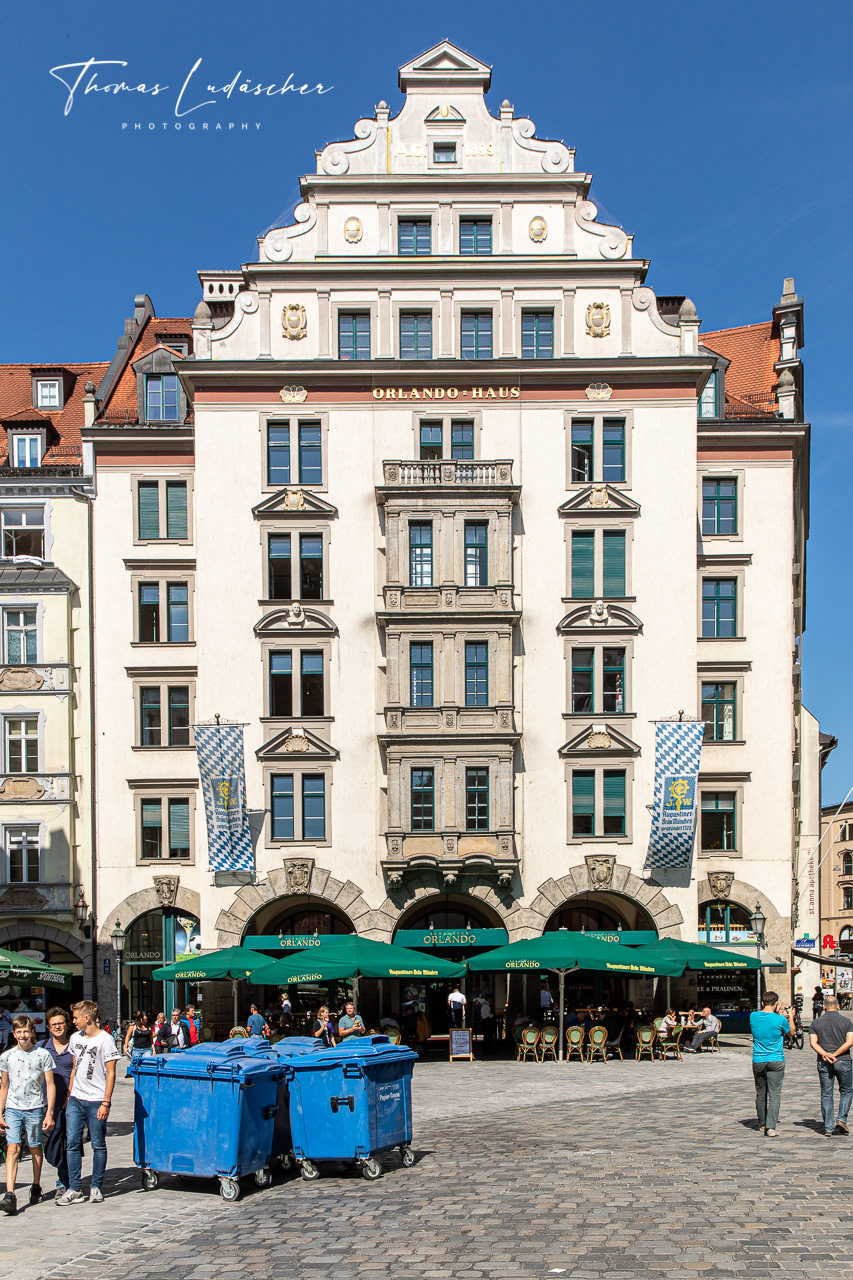

Marienplatz
Der Marienplatz liegt in der Altstadt am Kreuzungspunkt der beiden Hauptachsen, der Ost-West-Achse zwischen Isartor und Karlstor, die Teil der Salzstraße von Salzburg bzw. Reichenhall über Landsberg am Lech in die Schweiz war, und der Süd-Nord-Achse zwischen Sendlinger Tor und dem im 19. Jahrhundert abgebrochenen Schwabinger Tor an der Stelle des heutigen Odeonsplatzes. Im Norden wird er vom Neuen Rathausbegrenzt, im Osten vom Alten Rathaus, die Süd- und Westseite bilden Kaufhäuser und sonstige Geschäftshäuser, oft mit Gastronomie. Er ist gut 100 Meter lang und etwa 50 Meter breit.
Das Neue Rathaus am Marienplatz in München ist Sitz des Oberbürgermeisters, des Stadtrates und Hauptsitz der Stadtverwaltung München. Es wurde von 1867 bis 1909 in drei Bauabschnitten durch Georg von Hauberrisser im neugotischen Stil erbaut.
Marienplatz is located in the Old Town at the intersection of the two main axes, the east-west axis between Isartor and Karlstor, which was part of the Salt Road from Salzburg and Reichenhall via Landsberg am Lech to Switzerland, and the south-north axis between Sendlinger Tor and the Schwabinger Tor, which was demolished in the 19th century, on the site of today's Odeonsplatz. In the north it is bordered by the New Town Hall, in the east by the Old Town Hall, the south and west sides are department stores and other commercial buildings, often with restaurants. It is a good 100 meters long and around 50 meters wide.
The New Town Hall at Marienplatz in Munich is the seat of the Mayor, the City Council and the headquarters of the Munich City Administration. It was built in three phases by Georg von Hauberrisser from 1867 to 1909 in the neo-Gothic style.
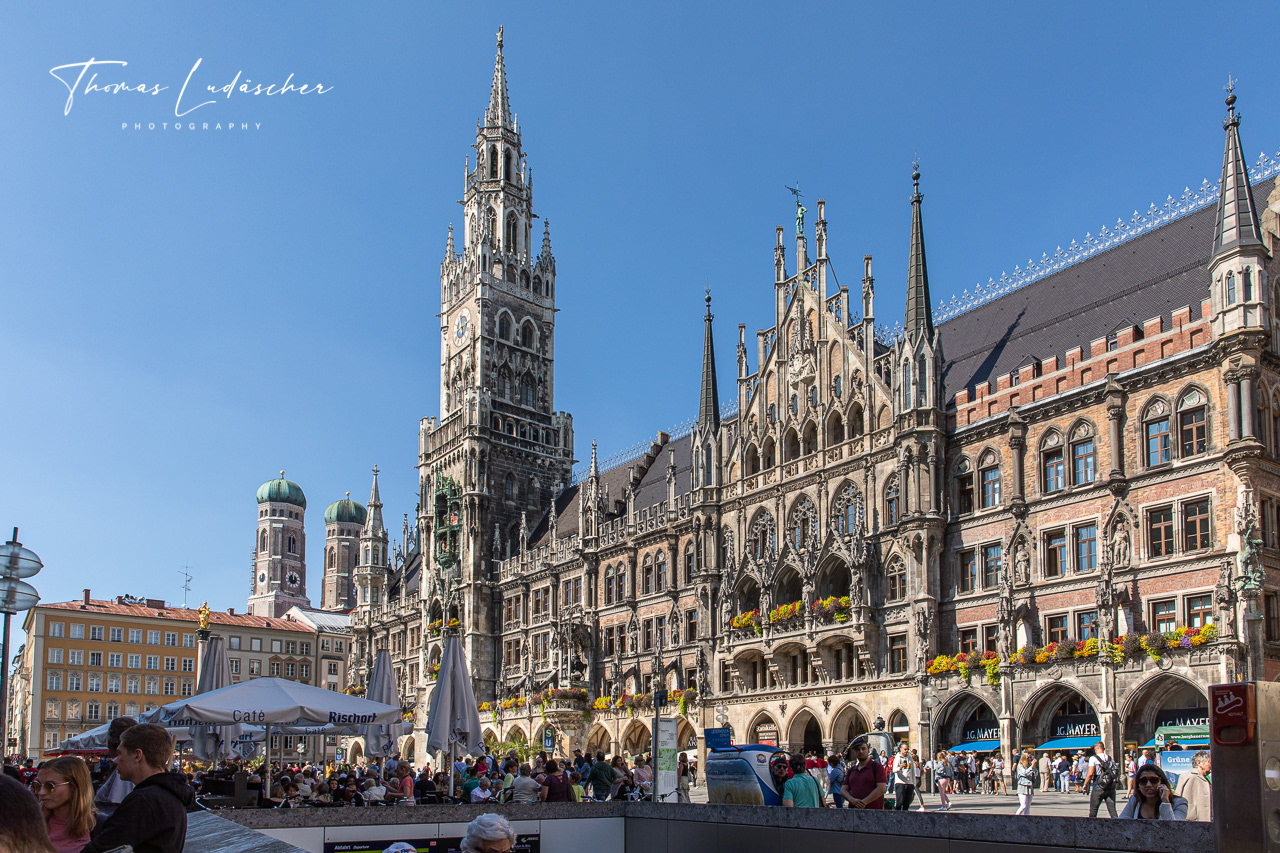
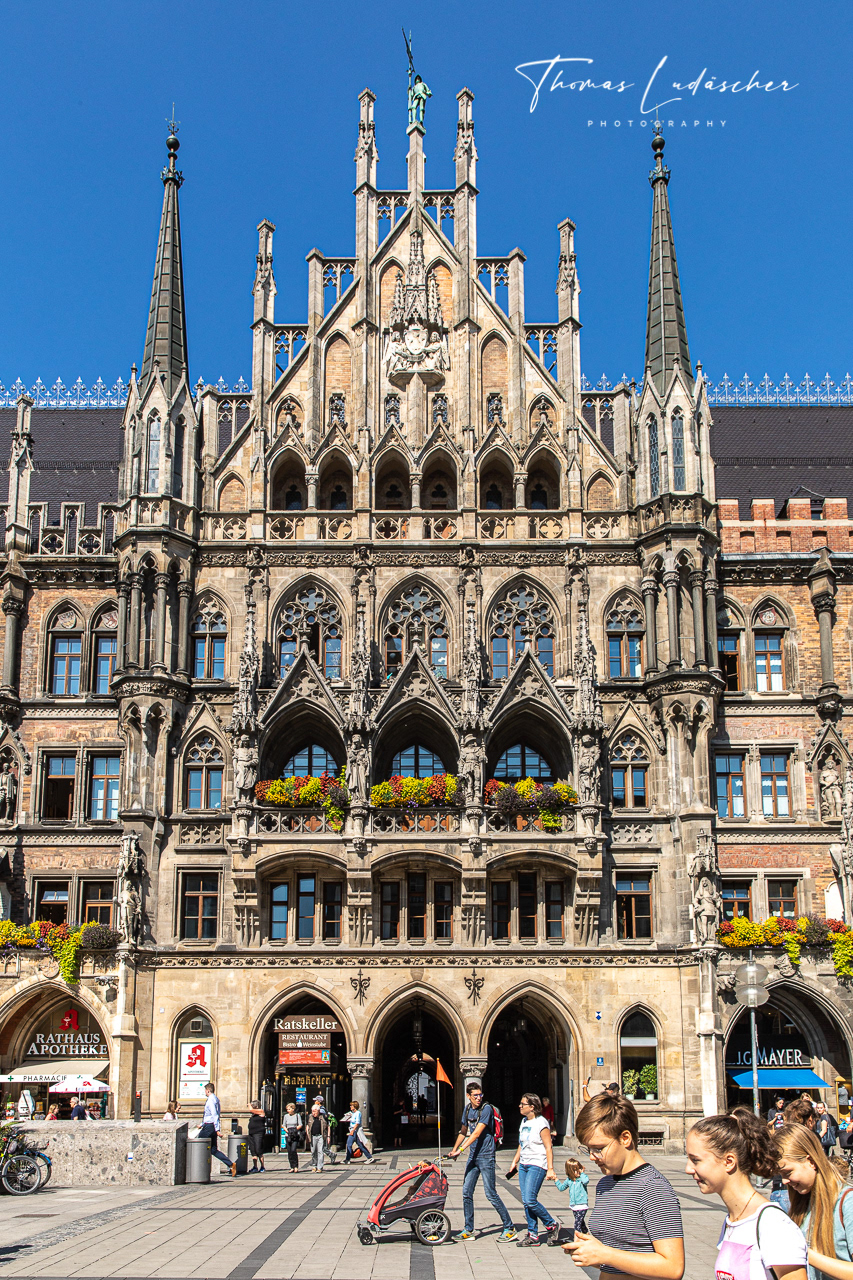

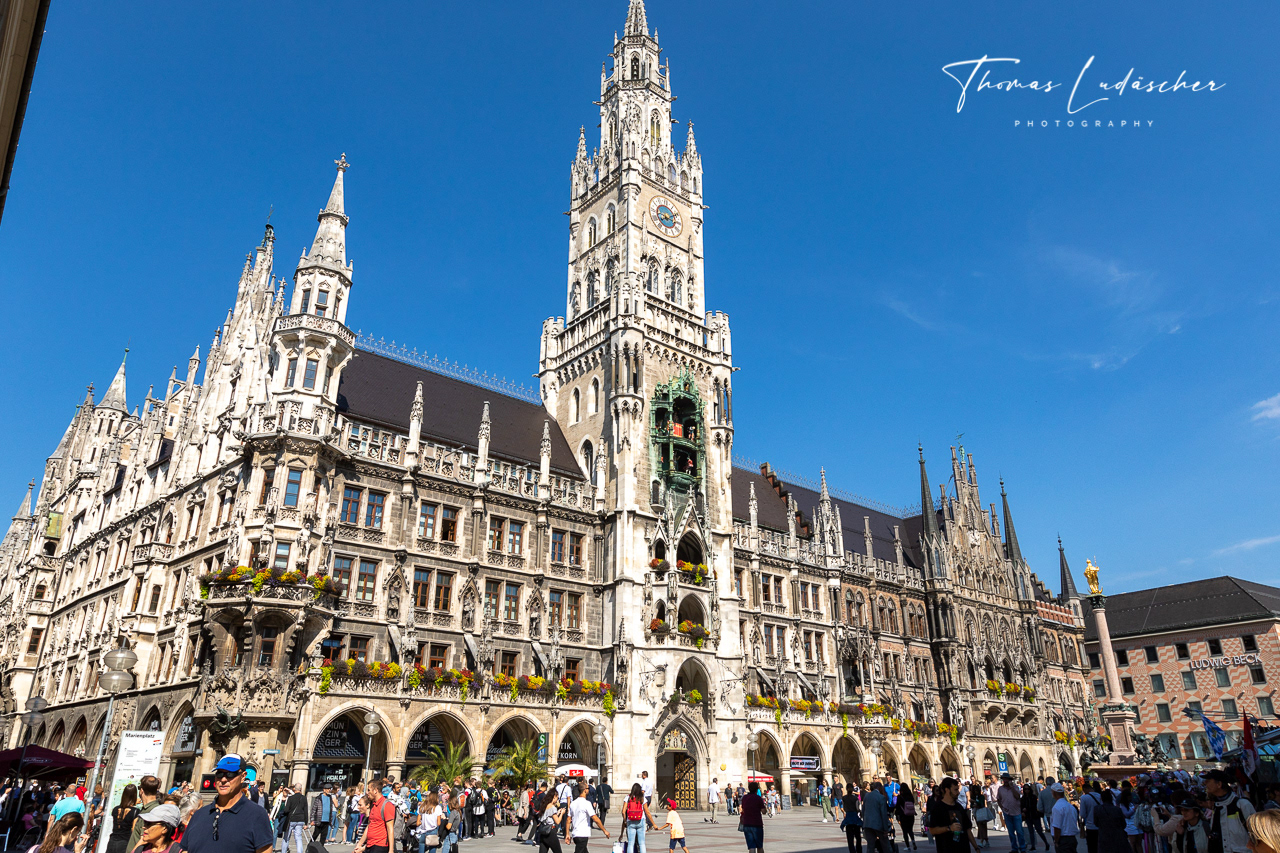
Die Mariensäule auf dem Marienplatz in München ist ein Maria geweihtes Standbild auf einer Säule. Maria wird hier als Patrona Bavariae (Schutzpatronin Bayerns) verehrt. Die Mariensäule ist von einer vergoldeten Marienstatue aus Bronze gekrönt, die vermutlich von Hubert Gerhard 1593 für das Grab Wilhelms V. geschaffen und bis 1613 für den Hochaltar der Münchner Frauenkirche verwendet wurde.
1639 wurden auf dem Sockel vier Bronzeputten hinzugefügt, welche sich allegorisch auf den Psalm 91 Vers 13 beziehen, der in gekürzter Form auf den Schilden wiedergegeben ist: „Super aspidem et basiliscum ambulabis et leonem et draconem conculcabis“ - „über die Schlange und den Basilisken wirst du schreiten und den Löwen und den Drachen wirst du zertreten.“ Die Heldenputti stehen im Kampf mit vier als Tiere dargestellten Menschheitsplagen. Der Löwe verkörpert den Krieg, der Basilisk – ein Fabelwesen – die Pest, ein Drache den Hunger und eine Schlange den Unglauben. Die vier Darstellungen wurden vom bis heute namentlich nicht bekannten „Meister der Heldenputti“ (wahrscheinlich ein Wachsbildner) gestaltet und von dem Bronzegießer Bernhard Ernst angefertigt.
The Marian Column on Marienplatz in Munich is a statue dedicated to Mary on a column. Mary is venerated here as the Patrona Bavariae (patron saint of Bavaria). The Marian column is crowned by a gilded bronze statue of the Virgin Mary, which was probably created by Hubert Gerhard in 1593 for the grave of William V and used for the high altar of the Munich Frauenkirche until 1613.
In 1639, four bronze putti were added to the base, allegorically referring to Psalm 91 verse 13, which is reproduced in an abridged form on the shields: “Super aspidem et basiliscum ambulabis et leonem et draconem conculcabis” - “about the serpent and the basilisk you will walk and you will trample on the lion and the dragon.” The hero putti are in battle with four plagues of humanity depicted as animals. The lion represents war, the basilisk – a mythical creature – represents plague, a dragon represents hunger and a snake represents disbelief. The four depictions were designed by the “Master of Hero Putti” (probably a wax sculptor), who is still unknown by name, and made by the bronze caster Bernhard Ernst.
